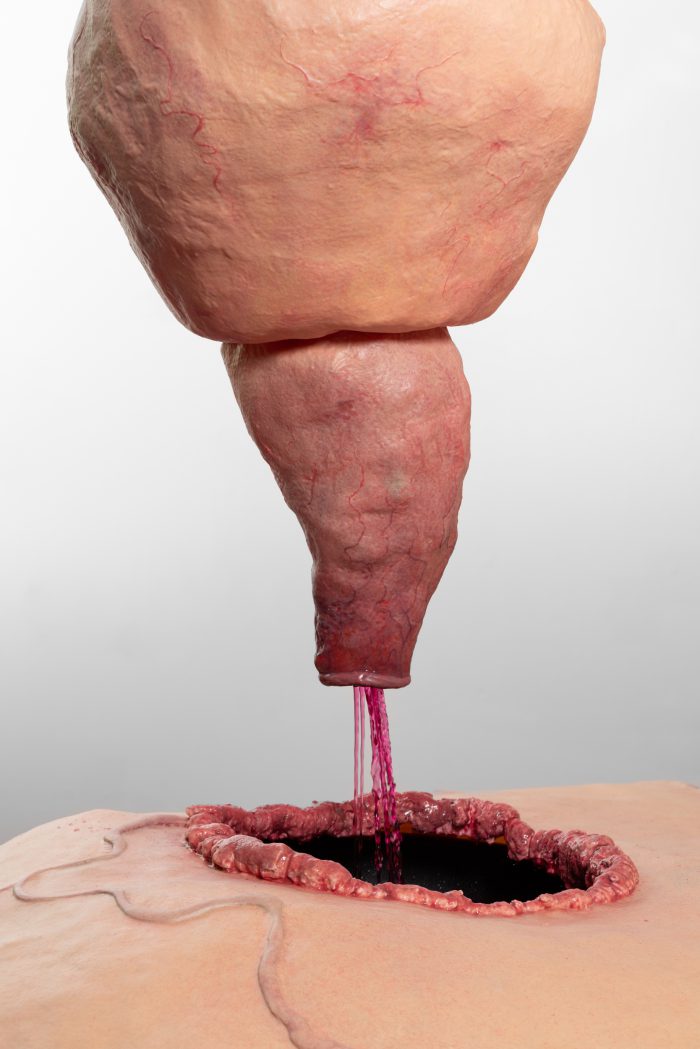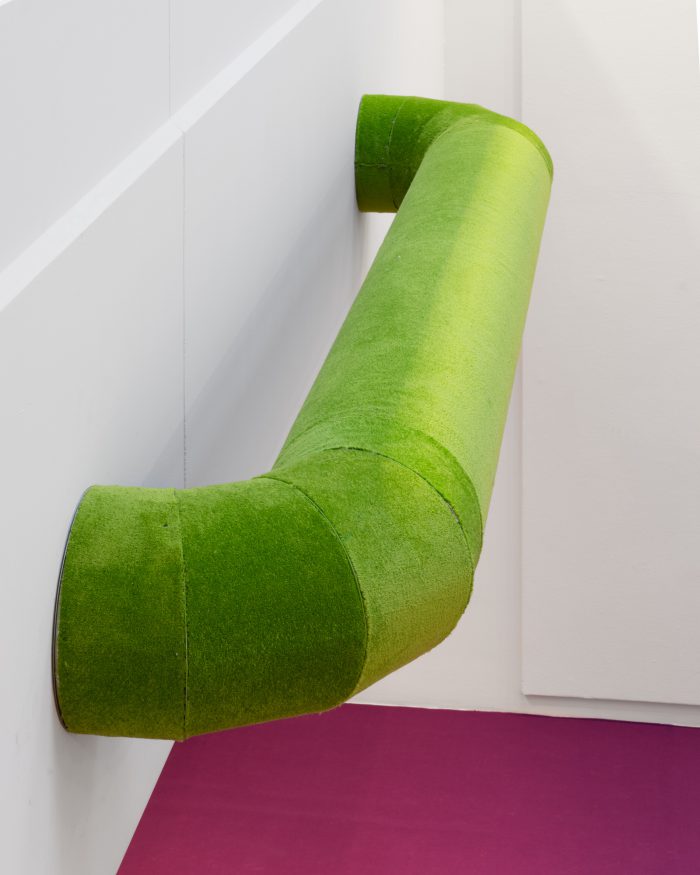Marie Munk
GREAT PETS
13.12.2019–01.03.2020
Vernissage:
12.12.2019,17:00–20:00
Marie Munks første soloudstilling i Danmark udfolder sig som en feberdrøm om fremtidens bioteknologiske verden. Udstillingen Great Pets er en totalinstallation, der inviterer gæster til at træde ind i et både velkendt og fremmed landskab. På den ene side ligner installationen en af vor tids børnesikrede legepladser, hvis kunstgræs og krasse faldgummi-farver iscenesætter en sært kunstig og tæmmet natur. På den anden side ligner udstillingen et zoologisk vivarium, hvor en dyreart lever i en karikeret version af sit naturlige miljø. Men totalinstallationen er ikke indrettet til børn eller dyr. Landskabet er beboet af organismer, der rører på sig og ser livagtige ud – og dog minder de ikke om nogen kendte former for liv.
Marie Munk har skabt sine sære væsener med lag på lag af silikone indfarvet med pigment. De ser syntetiske ud men er også animerede af mekanik. Deres hud er naturtro, men det er ikke en natur man kender. Stilen er hyperrealisme, men den realitet eller virkelighed, som her gengives, findes ingen andre steder. Udstillingen er som sådan ikke et billede på vores samtid. Om noget peger den på en forestilling om fremtiden.
Marie Munk er bl.a. optaget af opfinder og fremtidsforsker Raymond Kurzweils teori om en tiltagende konvergens mellem genetik, nanoteknologi og robotvidenskab – også kaldet GNR – der vil afstedkomme en bioteknologisk revolution dirigeret af overlegen maskinintelligens. Resultatet vil være en opgradering af mennesket, herunder nyvunden udødelighed, som mennesket på sit nuværende udviklingstrin endnu ikke kan begribe. Marie Munks version af denne revolution handler imidlertid ikke blot om et opgraderet og optimeret menneske. Vi har snarere at gøre med en helt anden skabning; en ny art eller race, som vi endnu ikke har et forhold til eller et begreb om. Organismerne har tilsyneladende deres eget liv, som er svært at forstå. De er skabt af mennesker, men det er ikke åbenlyst, at de også er skabt til og for mennesker. De er på en og samme tid søde og skræmmende. De kan givetvis vække følelser af både empati og fremmedgørelse – og måske især begge dele på samme tid.
Udstillingens titel Great Pets kan betyde flere ting, bl.a. ’Fantastiske Kæledyr’ og ’Store Kæledyr.’ Titlen leder tankerne hen på den boomende robotkæledyrsindustri, der sælger mekaniske og reaktive hundehvalpe til børn og babysæler til plejehjem. Men titlen flirter også med en umulighed. For kan kæledyr ikke blive så store, at de vokser deres ejere over hovedet? Marie Munks kæledyr er så store, at de næsten ikke længere er kæledyr. Måske er de billeder på, hvordan et forvredet størrelsesforhold mellem mennesker og maskiner også forskyder magtforholdet. Spørgsmålet om, hvem der kæler for hvem, kan også blive et spørgsmål om, hvem der kontrollerer hvem. Folk fra sci-fi forfatteren Samuel Butler (1835-1902) til Apple-grundlægger Steve Wozniak (1950) har ikke blot spekuleret over, hvorvidt vi vil behandle teknologien, som vi hidtil har behandlet hunde; også om teknologien en dag vil behandle os som hunde, som kæledyr, hvilket både kan være for det bedre og værre.
Great Pets kan anskues som et eksperiment. I 1890’erne viste den russiske fysiolog Ivan Pavlov (1849-1936), at hunde kan trænes til at savle blot ved frembringelsen af en lyd. I dag demonstrerer teknologivirksomheder, at vi mennesker kan trænes til uafladeligt at tjekke vores ’feeds’ på sociale medier. På udstillingen undersøges og udstilles også, hvordan vi mennesker reagerer på kunstige kæledyr.
Når man ankommer til Tranen i stueetagen, vil man automatisk kigge op på de større væsener. Bevæger man sig op på 1. sal, vil man kigge ned på dem. Bevæger man sig rundt på udstillingen, kommer man måske ikke bare tæt på – og i øjehøjde med – disse feberdrømme om en fremtidig bioteknologisk revolution. Måske vil man også se op til dem eller ned på dem. Den ene synsvinkel kan udelukke den anden – eller supplere den.
Udstillingen ledsages af litteratur udvalgt af Marie Munk og Tranen. Her vil man bl.a. finde illustrerede bøger af geolog og palæontolog Dougal Dixon(1947), der siden debuten Fremtidens dyreliv – efter mennesket (1981/1982) er blevet kendt som en af grundlæggerne af genren 'spekulativ evolution'.
Toke Lykkeberg
Leder af Tranen
Marie Munk (1988) bor og arbejder i København. Hun er uddannet på Royal College of Art i London. Hun deltager p.t. også på Tranens omrejsende udstilling EXTEMPORARY: Art out of time, der i 2019 præsenteres på samtidskunstcentret NCCA Arsenal i Nizhny Novgorod, Rusland, og i 2020 på samtidskunstmuseet PERMM i Perm, Rusland.
Great Pets er sjette udstilling i Tranens program med ekstemporær kunst. Fokus er på den del af samtidskunsten, som ikke er fokuseret på samtiden. Når alt fra økosystemer til teknologi udvikler sig med stadig højere hastighed, bliver samtiden flygtig og uhåndgribelig. Den skrumper. Til gengæld vokser vor viden om fortiden konstant. Spekulationer om fremtiden tager til. Spørgsmålet om, hvor vi befinder os idag, bliver til et spørgsmål om, hvor vi kommer fra og hvor vi er på vej hen. Som del af denne bevægelse er megen samtidskunst ikke længere kontemporær, hvilket bogstaveligt talt vil sige ’med tiden.’ I stedet er den ’ekstemporær’, altså ’ude af tiden’ eller samtiden.
Udstillingen er støttet af Det Obelske Familiefond, Ragnvald og Ida Blix’ Fond, Den Hielmstierne-Rosencroneske Stiftelse, Statens Kunstfond og Statens Værksteder for Kunst.
Marie Munk’s first solo exhibition in Denmark unfolds as a fever dream about a future biotechnological world. The exhibition Great Pets is an installation that invites guests to enter a both familiar and alien landscape. The installation resembles one of today’s childproof playgrounds whose artificial grass and crass rubber concrete colors stage an oddly artificial and domesticated nature. The installation also recalls a zoological vivarium, where some animal species roams a caricature of its natural habitat. But, the total installation is neither made for kids nor animals. The landscape is inhabited by moving organisms that look lifelike, yet not reminiscent of any known form of life.
Marie Munk has crafted her strange creatures using layers upon layers of silicone dyed with pigment. They look synthetic though lively, animated by using mechanics. Their skin is true to nature but a nature unknown to man. The style is hyperrealism, but the reality presented in the exhibition is nowhere else to be found. As such, the show is not exactly an image of our present, but rather a presentiment of things to come.
Marie Munk is, among others, preoccupied by inventor and futurologist Raymond Kurzweil's theory of an increasing convergence between genetics, nanotechnology, and robotic science – called GNR – predicted to spark a biotechnological revolution under the influence of a superior machine intelligence. The result will be an upgraded version of homo sapiens, including newfound immortality, which man at its present stage of evolution cannot yet grasp. However, Marie Munk's version of this revolution is not simply an upgraded and optimized human being. The offshoot is, rather, a completely different being; a new species or race, which we cannot yet relate to or even grasp. Apparently, Marie Munk’s organisms lead a life of their own, which is difficult to comprehend. They are made by the artist, made by humans, but it is uncertain for whom they are made. They are at the same time both cute and uncanny. They may arouse feelings of both empathy and alienation – and probably, and in particular, both at the same time.
The title of the exhibition Great Pets might mean different things such as ‘fantastic pets’ or ‘large pets’. It might hint at the booming robotic pets-industry selling mechanic and reactive puppies to kids and baby seals to old people’s homes. But the title is also toying with an impossibility: for might pets not end up being so big that they outgrow their owners? The pets of Marie Munk have grown so large in size that they are almost no longer pets. Maybe the change in scale between humans and machines invokes changing power relationship between them? The question of who is petting whom may also be a question of who controls whom. People such as the Sci-fi author Samuel Butler (1835-1902) and the Apple founder Steve Wozniak (1950-) have not only given thought to whether we will treat technology the way we have hitherto treated dogs. They have also speculated about whether one day technology will treat us like dogs, like pets – for better or worse.
Great Pets can be seen as an experiment. In the 1890’s, Russian physiologist Ivan Pavlov (1849-1936) demonstrated how dogs can be trained to drool simply by use of sound or visuals. Today, big tech corporations expose how the human race can be trained to constantly check social media feeds. The exhibition also examines and exhibits the way in which humans, i.e. visitors to the show, respond to artificial pets.
When you arrive at Tranen’s ground floor, you will automatically raise your eyes and stare at the bigger creatures. When you move on to the first floor, you will gaze down upon them. When you move around in the exhibition, you might not only be close to – and eye to eye with – these fever dreams of a future biotechnological revolution. You may also look up to them or down upon them. One point of view may exclude another – or augment it.
The exhibition is accompanied by a selection of literature selected by Marie Munk and Tranen. Among others, there will be illustrated books by geologist and paleontologist Dougal Dixon (1947-), who has established himself as one of the founders of the genre 'speculative evolution' since his debut After Man: A Zoology of the Future (1981)
Toke Lykkeberg
Director of Tranen
Marie Munk (1988) lives and works in Copenhagen. She has studied at The Royal College of Art in London and is currently part of Tranen’s traveling exhibition EXTEMPORARY: Art out of time at the contemporary art center NCCA Arsenal in Nizhny Novgorod, Russia, in 2019 and at the contemporary art museum PERMM in Perm, Russia, in 2020.
Great Pets is the sixth exhibition in Tranen’s program about extemporary art. The focus is on contemporary art that is not primarily focused on our contemporary condition. When everything from climate to technology evolves at ever greater pace, the present becomes ephemeral and intangible. The present starts to shrink. Meanwhile, our knowledge of the past increases. Speculations about the future abound. As part of this development, a lot of art is no longer contemporary – which literally means ‘with time.’ Instead, art is rather ‘extemporary, i.e. ‘out of time’.
The exhibition is generously supported by Det Obelske Familiefond, Ragnvald og Ida Blix’ Fond, Den Hielmstierne-Rosencroneske Stiftelse, the Danish Arts Council and Danish Art Workshops.
Anbefalet læsning / Recommended reading:
Forfatter / Author
Titel / Title
Udgivelsesår / Publication date
Samuel Butler
Erewhon: or, Over the Range
1872
Dougal Dixon
After Man: A Zoology of the Future
1981
Dougal Dixon
The New Dinosaurs: An Alternative Evolution
1988
Dougal Dixon
Man After Man: An Anthropology of the Future
1990
Yuval Noah Harari
21 Lessons for the 21st Century
2018
Ray Kurzweil
The Singularity Is Near: When Humans Transcend Biology
2005
Marshall McLuhan
The Medium is the Massage
1967
Sherry Turkle
Reclaiming Conversation: The Power of Talk in a Digital Age
2015
Sherry Turkle
Alone Together: Why We Expect More from Technology and Less from Each Other
2011
Olaf Stapledon
Last and First Men
1930




















